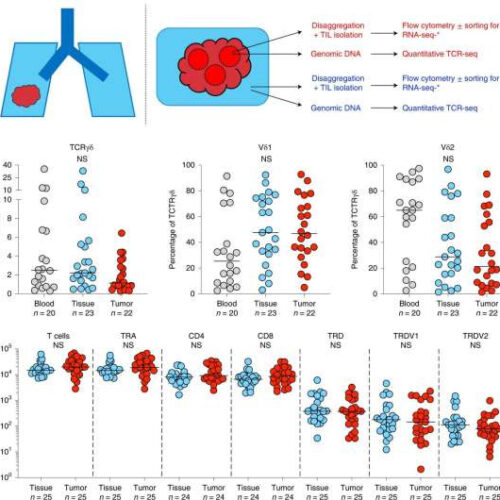by Indiana University School of Medicine Accelerated plaque deposition in 5xFAD mice deficient in Cx3cr1. (A) Accumulation of MOAB2+ Aβ42 plaques in (top panels) 4 month-old vs. (bottom panels) 6 month-old 5xFAD;Cx3cr1+/+ and 5xFAD; Cx3cr1−/− mice. Scale bars = 500 μm. Quantification of %MOAB2+ areas in the (B) cortex and (C) hippocampus of 4 and 6 month-old 5xFAD;Cx3cr1+/+ (black bars) and 5xFAD;Cx3cr1−/− (gray bars) mice. Data in B,C represent...
Tag: <span>Immune cell</span>
Targeting one type of immune cell with another slows cancer growth in preclinical studies
by The Mount Sinai Hospital Credit: CC0 Public Domain A new approach to cancer immunotherapy that uses one type of immune cell to kill another—rather than directly attacking the cancer—provokes a robust anti-tumor immune response that shrinks ovarian, lung, and pancreatic tumors in preclinical disease models, according to researchers at the Icahn School of Medicine...
Researchers identify immune cell that helps kill bladder cancer tumors
THE MOUNT SINAI HOSPITAL / MOUNT SINAI SCHOOL OF MEDICINE New York, NY (Sept. 12, 2022) — Mount Sinai researchers have made two important discoveries about the mechanism by which bladder cancer cells foil attacks from the immune system. The research, published in Cancer Cell in September, could lead to a new therapeutic option for patients with these...
Cellular waste may supercharge immune cell function
by Van Andel Research Institute Credit: CC0 Public Domain The immune cells that protect us from infection and cancer seek out a wide array of fuel sources to power their function—including some long thought to be cellular waste products. The findings, published today in Cell Metabolism, lay the foundation for future personalized dietary recommendations designed to supercharge...
Immune cell linked to better lung cancer survival
by King’s College London Experimental design and γδ T cell composition in lung tissues and NSCLCs. a, Overview of study design. Paired tumor regions (red) and NT lung tissues (blue) collected under the TRACERx Study were enzymatically digested to extract tissue/TILs. TILs were cryopreserved and thawed at a later date for flow cytometry ± RNA-seq. In parallel,...
Recovery from muscle loss injuries hindered by immune cell conflicts
by Jim Lynch, University of Michigan Credit: CC0 Public Domain Tissues often fail to regenerate from traumatic muscle-loss injuries such as gunshot wounds and car accidents, and new research in mice from the University of Michigan sheds light on why. The findings suggest new treatment strategies that could eventually restore function and prevent limb loss....
Ally and enemy? Scientists explore immune cell suspect in Alzheimer’s disease
by Bill Hathaway, Yale University Fig. 1: Characterization of microglia-like cells in mhCOs. a Schematic for generating mhCOs. 10% of PU.1-infected hESCs were mixed with 90% parental HES3 hESCs, and PU.1 priming and full induction were performed on day 2 and 18, respectively. b Expression of microglia-related genes from control hCOs and mhCOs (30-day and...
Immune cell receptor and ligand regulation: A therapeutic avenue for inflammatory diseases
IMAGE: NEURAMINIDASE SUPPRESSES AUTOIMMUNE ARTHRITIS AND ENCEPHALOMYELITIS BY INHIBITING DENDRITIC CELL AND OSTEOCLAST ACTIVITY THROUGH REMOVAL OF SIALIC ACID, THEREBY EXPOSING ASIALO-BIANTENNARY N-GLYCAN (NA2) AND GENERATING INHIBITORY SIGNALS THROUGH DENDRITIC CELL IMMUNORECEPTOR (DCIR). CREDIT: YOICHIRO IWAKURA FROM TOKYO UNIVERSITY OF SCIENCE Immune cells play a key role in mediating inflammatory responses. Dysregulation in signaling mechanisms...
Immune cell ‘hubs’ discovered hiding in tumors
by Sarah C. P. Williams, Broad Institute of MIT and Harvard In a subset of human colorectal tumors, immune cells such as activated and potentially tumor-reactive T cells (white, green, and magenta) are organized into “hubs” around malignant cells (blue) expressing molecules (yellow) that attract immune cells. Credit: Joshua Pirl, Vjola Jorgji, Linda Nieman, Jonathan Chen....
Early lung cancer coopts immune cell into helping tumors invade the lungs
by The Mount Sinai Hospital Myeloid immune cells alongside red blood cells in an electron micrograph of human blood. Credit: National Cancer Institute Immune cells that normally repair tissues in the body can be fooled by tumors when cancer starts forming in the lungs and instead help the tumor become invasive, according to a surprising discovery reported...









